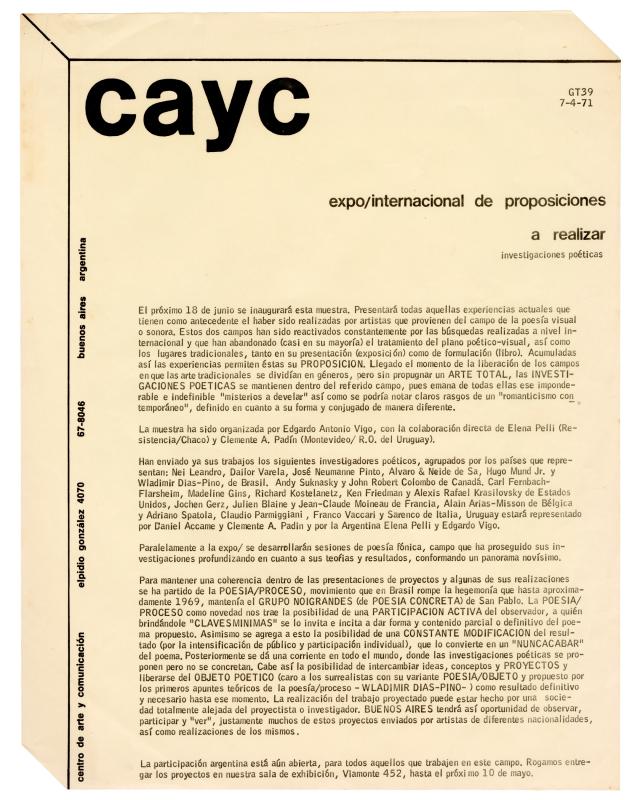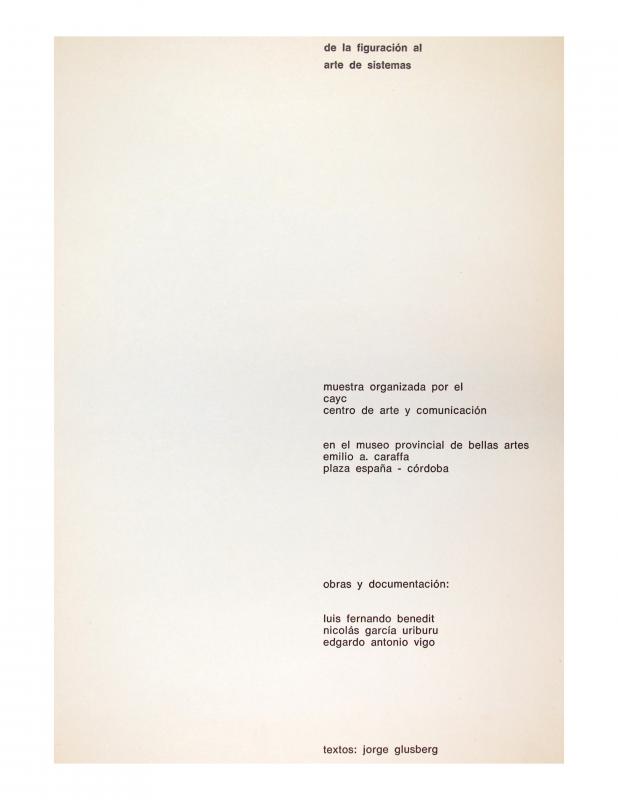Ever since it was founded, the CAYC (Centro de Arte y Comunicación), helmed by the cultural promoter, artist, and businessman Jorge Glusberg, was intended as an interdisciplinary space where an experimental art movement could flourish. The establishment of collaborative networks connecting local and international artists and critics played an important role in this process. The exhibitions shone a light on these exchanges, in which overviews of trends or individual artists provided an introduction to the innovations of international contemporary art and made Argentine and Latin American artists better known on the global scene.
Over the course of his varied career, Edgardo Antonio Vigo (1928–1997) produced objects, prints, signs, mail art, and visual poetry. He founded the magazines Diagonal Cero (1961) and Hexágono (1971). He organized the Expo/Internacional de Novísima Poesía/69 (Instituto Di Tella) in 1969, inviting experimental artists from all over the world who presented works that ranged from visual poetry to electronic media for sound poetry. That exhibition was a forerunner to the one presented by the CAYC in June 1971. [For more information about the Exposición Internacional de Proposiciones a realizar. Investigaciones poéticas, see GT-39 (doc. no. 1476286)].
Vigo was a regular participant in the CAYC’s activities from the time it was created in 1968 until the mid-1970s. He was one of the three artists invited to take part in De la Figuración al Arte de Sistemas (1970) (see doc. no. 761141), the exhibition that the CAYC presented at the Museo Emilio Caraffa in Cordoba, Argentina, where the category of “arte de sistemas” was mentioned for the very first time. When the Grupo de los Trece was started in 1971, however, he did not join the group, although he maintained his connection to the center in a relationship based on mutual collaboration. He found the center to be compatible with his own discourse and actions in both an experimental and ideological sense in terms of his convictions concerning the struggle for political and economic freedom in Latin American countries.
In 1974 the CAYC began focusing a great deal of its attention on this project, promoting a variety of initiatives in exhibitions that traveled around a contemporary circuit consisting of new cultural spaces and centers that were emerging in Europe at the time. As his submission to the exhibition Arte de Sistemas en Latinoamérica in Belgium, Vigo sent Bande Dessinée Hermetique Premiėre (First Animated Hermetic Strip, 1974). The event established systems art as a movement that positioned the CAYC as the focal point for the exposure and promotion of Latin American Conceptualism. The exhibition visited several European cities from 1974 to 1976, presenting an overview of the region’s recent works “adapted” by Glusberg to the original concept of systems art.
As part of the promotional efforts in support of the first edition of this exhibition at the ICC (Internationaal Cultureel Centrum) in Antwerp, this newsletter includes a reproduction of Vigo’s essay about his work Historietas herméticas (1974), written for the catalogue. The catalogue was conceived as a complementary but independent piece for each exhibition. The catalogues (folders holding loose sheets of paper) included a fixed bilingual prologue and a selection of artists’ statements that varied from one event to another.
Beginning in 1971, Vigo contributed to the magazine Hexágono 71, in a theoretical capacity as an editor and a practical capacity as an artist, with a critical focus on comic strips. (Julia Cisneros, “Edgardo Antonio Vigo: Re-escritura e historieta,” Órbita Vigo, 2019.)


